 |
 |
 |
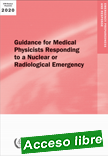 |
Guidance for Medical Physicists Responding to a Nuclear or Radiological Emergency
IAEA ¦ EPR-Medical Physicists ¦ Date published: 2020 ¦ 73 pages ¦ 18 figures
Radiation emergencies can occur anywhere, at any time and protecting the health and safety of the affected individuals is the first priority. How can people, including medical personnel, be assured that they are protected when there are no radiation experts on site?
Medical physicists, uniquely qualified to provide emergency support are usually not trained in emergency preparedness and response (EPR).
|
A recently issued IAEA publication, the Guidance for Medical Physicists Responding to a Nuclear or Radiological Emergency, provides specific details to help close that gap and enable clinically qualified medical physicists to effectively support first responders during a nuclear or radiological accident. The publication has also been condensed into an accompanying pocket guide for swift information.
|
 |
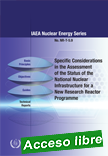 |
Specific Considerations in the Assessment of the Status of the National Nuclear Infrastructure for a New Research Reactor Programme
IAEA Nuclear Energy Series No. NR-T-5.9 ¦ STI/PUB/1907 ¦ Date published: 2021¦ 75 pages
The assessment approach described in this publication provides a comprehensive means to determine the status of the infrastructure conditions relevant to all issues detailed in IAEA Nuclear Energy Series No. NP-T-5.1, Specific Considerations and Milestones for a Research Reactor Project.
|
This approach can be used by any interested Member State for self-assessment to identify weaknesses and to determine the additional work needed to develop its national nuclear infrastructure for research reactor programme to an appropriate level. Member States planning to embark on both a research reactor programme and a nuclear power programme, may refer to this publication to ensure that the approach and methodology for the implementation of both programmes is harmonized, efficient and effective.
|
 |
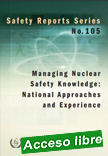 |
Managing Nuclear Safety Knowledge: National Approaches and Experience
IAEA Safety Reports Series No. 105 ¦ STI/PUB/1938 ¦ Date published: 2021 ¦45 pages
This publication provides practical guidance and information to Member States on how to manage nuclear safety knowledge at the national level, beyond the boundaries of individual organizations. It describes the underlying concepts, challenges and available approaches and tools, as well as summarizing the experience gained by Member States to date.
|
The publication is in line with the ultimate objective of all nuclear safety knowledge management activities, which is to sustain and improve the competence of individuals and the capacity of organizations or countries to use such knowledge effectively and responsibly.
|
 |
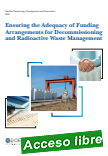 |
Ensuring the Adequacy of Funding for Decommissioning and Radioactive Waste Management
OECD - Nuclear Energy Agency ¦ NEA No. 7549 ¦ Date published: 2021 ¦ 232 pages
This report by the OECD Nuclear Energy Agency (NEA) combines a solid conceptual framework with the insights from twelve case studies of NEA member countries to propose a new approach to the adequacy of funding that is both robust and flexible. Current funding systems in NEA countries are overall adequate. The challenges ahead however are formidable:
|
decommissioning and RWM are moving from design to implementation, returns on assets are low and societal preferences can evolve. The very long-term nature of the solutions, in particular for radioactive waste disposal, is also not easily compatible with the economic lifetimes of the original liability holders. This requires that all elements of the system – accrued funds, expected future returns, the lifetimes of nuclear power plants, the expected costs of politically sustainable technical solutions and the liabilities for residual risks – are reviewed and realigned at regular intervals. Complementing existing approaches with such a circular approach will strengthen funding arrangements and ensure their adequacy for decades to come.
|
 |
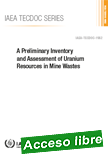 |
A preliminary inventory and assessment of uranium resources in mine wastes
IAEA TECDOC No. 1952 ¦ Date published: 2021 ¦ 118 pages
Seismic instrumentation systems are important elements for plant safety. They provide crucial information for the assessment of safety required to restart a plant after a shutdown caused by an earthquake. This publication presents information and experience related to the development of seismic instrumentation systems and the utilization of data recorded by them, based on recent seismic events.
|
The publication is intended to be a reference for developing effective post-earthquake actions/procedures. It describes the typologies of seismic instrumentation systems and their application for obtaining ‘earthquake levels’ and ‘damage indicating parameters’ that are used to predict the extent of seismic damage caused by the recorded earthquake motions. It complements IAEA Safety Standards Series No. NS-G-1.6, Seismic Design and Qualification for Nuclear Power Plants, and Safety Reports Series No. 66, Earthquake Preparedness and Response for Nuclear Power Plants, as a technical publication relevant to seismic safety for new and existing nuclear installations.
|
 |
 |
Occupational Exposures at Nuclear Power Plants
OECD - Nuclear Energy Agency ¦ NEA No. 7536 ¦ Date published: 2021 ¦ 136 pages
The Information System on Occupational Exposure (ISOE) is jointly sponsored by the Nuclear Energy Agency (NEA) and the International Atomic Energy Agency (IAEA). Since 1992, ISOE has provided a forum for radiological protection professionals from nuclear licensees and national regulatory authorities worldwide to share dose reduction information and operational experience aiming to improve the optimisation of radiological protection at nuclear power plants.
|
As of 31 December 2018, the ISOE Programme included 76 participating licensees in 31 countries (352 operating units, 61 shutdown units and 10 units under construction and/or commissioning), as well as 28 regulatory authorities in 26 countries. The ISOE database contains occupational exposure information for 500 units, covering over 85% of the world’s operating commercial power reactors. In addition, the ISOE database contains dose data from 106 reactors that are shut down or in some stage of decommissioning.
While ISOE is well known for its occupational exposure data and analyses, the Programme’s strength comes from its objective to share such information broadly among its participants.
This 28th Annual Report presents the status of the ISOE Programme for the calendar year 2018. The report includes global occupational exposure data and analyses collected and accomplished in 2018, as well as information on the Programme achievements and principle events in participating countries.
|
 |
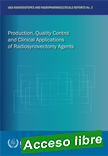 |
Production, Quality Control and Clinical Applications of Radiosynovectomy Agents
IAEA Radioisotopes and Radiopharmaceuticals Reports No. 3 ¦ STI/PUB/1915 ¦ Date published: 2021 ¦ 123 pages
Therapeutic radiopharmaceuticals play a major role in today's nuclear medicine with a positive impact on the diagnosis and treatment of diseases. One area of application is radiation synovectomy (RSV). Previously, RSV agents were often simple colloids. More recently, matrixes labelled with short/medium range beta emitters have been developed.
|
However, the lack of generic and peer-reviewed production, quality control as well as clinical application guidelines and recommendations, are a major concern for their application in patients. This publication presents recommendations and suggestions for production, quality control and quality assurance procedures for Member State laboratories in charge of radiopharmaceutical production, with a focus on the latest RSV agents. It also proposes standard operating procedures for RSV application in patients. The publication aims to assist both newcomers and those currently working in the field in establishing comparable levels of control.
|
 |
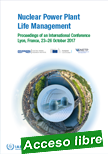 |
Nuclear Power Plant Life Management
IAEA Proceedings of an International Conference Held in Lyon, France, 23–26 October 2017 ¦
STI/PUB/1940 ¦ Date published: 2021 ¦ 52 pages
A plant life management (PLiM) programme is an effective tool that allows an operator to manage ageing effects in structures, systems and components (SSCs) for long term operation of nuclear power plants. Such a programme helps facilitate decisions concerning when and how to repair, replace or modify SSCs in an economically optimized way, while assuring that the highest levels of safety are maintained.
|
This publication is the proceedings of the fourth in a series of international conferences convened by the IAEA on nuclear power plant life management. The conference provided a forum for information exchange on national and international policies, as well as on regulatory practices, and for the demonstration of strategies, including their application in ageing management and PLiM programmes for operating and new nuclear power plants. The proceedings include the opening address, presentations of the keynote speakers, summaries of the individual technical sessions, and conclusions and recommendations of the chairperson of the conference.
|
 |
 |
2020 NEA Annual Report
OECD - Nuclear Energy Agency ¦ Date published: 2021 ¦ 99 pages
Despite the ongoing COVID-19 pandemic 2020 was a very active and impactful year at the NEA. The Agency quickly adjusted to the situation, switched to virtual methods of interaction, and continued to serve its member countries. The NEA community has stayed in contact via online meetings, webchats and web-based expert roundtables. A series of online public chats with energy ministers on the major issues of the day was launched alongside “virtual missions” to strengthen collaboration, explore potential future areas of co-operation and share experiences with member and partner countries.
|
Over the course of this year the NEA released flagship reports on deep geological repositories, reducing the construction costs of nuclear energy, nuclear data and electricity generating costs. It also issued policy briefs on the role of nuclear energy during COVID-19 and beyond. It organised conferences and workshops corresponding to the needs of member countries in the application and exploration of nuclear science and technology, including the NEA Workshop on Optimisation: Rethinking the Art of Reasonable and a special workshop on the human aspects of nuclear safety during the COVID-19 pandemic. The Agency also continued supporting nuclear capacity building efforts with events such as the WebChat on Gender Balance, a Global Nuclear Science and Engineering Commencement and the 7th International Mentoring Workshop in Science and Engineering, in which distinguished women scientists and engineers engaged with female high school students from Fukushima, Japan.
|
 |
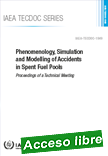 |
Phenomenology, Simulation and Modelling of Accidents in Spent Fuel Pools - Proceedings of a Technical Meeting
IAEA-TECDOC-1949 ¦ Date published: 2021 ¦ 264 pages
This publication summarizes the results of an IAEA technical meeting to review and discuss the analysis, simulation, and modelling of severe accident progression in spent fuel pools. The emphasis was on achieving a better understanding of drivers for improvement to address risks associated with accidents in spent fuel pools, progression to failure of the spent fuel, and the subsequent release of fission products.
|
Discussion sessions enabled the exchange of information regarding the analysis of severe accidents in spent fuel pools, the provision of an overview of current research and development (R&D) activities, and considerations for the planning and execution of further R&D. The meeting served as a forum for Member States to exchange knowledge on current and new code development and methodologies, to identify the gaps for future improvements, and gather information for collaboration on all these aspects.
|
 |
| |
|
|

|
|
|
| |
|
|
| |
| |
|
|
| |
| |
|
|
| |
| |
|
|
|
| |
| |
